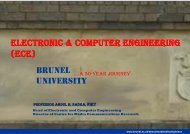Display of 3D Holoscopic content on ... - Brunel University
Display of 3D Holoscopic content on ... - Brunel University
Display of 3D Holoscopic content on ... - Brunel University
You also want an ePaper? Increase the reach of your titles
YUMPU automatically turns print PDFs into web optimized ePapers that Google loves.
ICT Project <str<strong>on</strong>g>3D</str<strong>on</strong>g> VIVANT– Deliverable 6.4<br />
C<strong>on</strong>tract no.:<br />
248420<br />
<str<strong>on</strong>g>Display</str<strong>on</strong>g> <str<strong>on</strong>g>of</str<strong>on</strong>g> <str<strong>on</strong>g>3D</str<strong>on</strong>g> <str<strong>on</strong>g>Holoscopic</str<strong>on</strong>g> C<strong>on</strong>tent <strong>on</strong><br />
Auto-stereoscopic <str<strong>on</strong>g>Display</str<strong>on</strong>g><br />
auto-stereoscopic display was designed to <str<strong>on</strong>g>of</str<strong>on</strong>g>fer lenticular lens design creating a variety <str<strong>on</strong>g>of</str<strong>on</strong>g> distinct <str<strong>on</strong>g>3D</str<strong>on</strong>g><br />
views. The <str<strong>on</strong>g>3D</str<strong>on</strong>g> Auto-stereoscopic display has an embedded hardware that accepts 2D-plus-depth<br />
format and renders 9 views to enable multiple viewers to see <str<strong>on</strong>g>3D</str<strong>on</strong>g> images at any <strong>on</strong>e time.<br />
The display player does not support 9-views <str<strong>on</strong>g>c<strong>on</strong>tent</str<strong>on</strong>g> as input. However, given that the <str<strong>on</strong>g>3D</str<strong>on</strong>g><br />
<str<strong>on</strong>g>Holoscopic</str<strong>on</strong>g> <str<strong>on</strong>g>c<strong>on</strong>tent</str<strong>on</strong>g> is recorded as a single 2D data, then <strong>on</strong>ly the 2D input is used. Furthermore it is<br />
necessary to acquire the various parameter <str<strong>on</strong>g>of</str<strong>on</strong>g> the lenticular sheet used by the Philips including the<br />
slanting angle. Three important parameters namely, the focal length and pitch <str<strong>on</strong>g>of</str<strong>on</strong>g> each lenslet and the<br />
slanting angle <str<strong>on</strong>g>of</str<strong>on</strong>g> the lenticular sheet are required by the s<str<strong>on</strong>g>of</str<strong>on</strong>g>tware developed at <strong>Brunel</strong> <strong>University</strong> to<br />
computer generate <str<strong>on</strong>g>3D</str<strong>on</strong>g> <str<strong>on</strong>g>Holoscopic</str<strong>on</strong>g> images for the Philips display. Unfortunately it was difficult to<br />
acquire this informati<strong>on</strong> from Philips. So we have adapted the informati<strong>on</strong> <strong>on</strong> an earlier versi<strong>on</strong><br />
published by Philips in 1999 for a 7 views <str<strong>on</strong>g>3D</str<strong>on</strong>g> LCD display. A s<str<strong>on</strong>g>of</str<strong>on</strong>g>tware tool has been developed to<br />
map the pixels <str<strong>on</strong>g>of</str<strong>on</strong>g> the 2D intensity distributi<strong>on</strong> <str<strong>on</strong>g>of</str<strong>on</strong>g> a <str<strong>on</strong>g>3D</str<strong>on</strong>g> holoscopic image to fit into a slanted lenticular<br />
structure <str<strong>on</strong>g>of</str<strong>on</strong>g> the Philips display. Unfortunately this [rocedure did not provide satisfactory results due<br />
to<br />
(i) adapting the lenticular optical characteristics from previous development is not<br />
accurate enough and may have caused some <str<strong>on</strong>g>of</str<strong>on</strong>g> the problems;<br />
(ii) Missing informati<strong>on</strong> about the lenticular sheet such as the focal length and pitch <str<strong>on</strong>g>of</str<strong>on</strong>g><br />
each lenslet;<br />
(iii) The display does not accept multiple inputs.<br />
Due to the fact that the auto-stereoscopic Philips display has been disc<strong>on</strong>tinued and no l<strong>on</strong>ger<br />
commercially available, it was not possible to get access to the necessary informati<strong>on</strong> to allow<br />
accurate mapping <str<strong>on</strong>g>of</str<strong>on</strong>g> the <str<strong>on</strong>g>3D</str<strong>on</strong>g> holoscopic image <strong>on</strong>to the display.<br />
To solve this problem, the <strong>Brunel</strong> team c<strong>on</strong>tacted a number <str<strong>on</strong>g>of</str<strong>on</strong>g> <str<strong>on</strong>g>3D</str<strong>on</strong>g> auto-stereoscopic diplay<br />
manufactures. Alioscopy <str<strong>on</strong>g>3D</str<strong>on</strong>g> Auto-Stereoscopic display is <strong>on</strong>e <str<strong>on</strong>g>of</str<strong>on</strong>g> the systems studied and<br />
experimented with as an example <str<strong>on</strong>g>of</str<strong>on</strong>g> State <str<strong>on</strong>g>of</str<strong>on</strong>g> the art <str<strong>on</strong>g>3D</str<strong>on</strong>g> Auto-Stereoscopic <str<strong>on</strong>g>Display</str<strong>on</strong>g> to ensure the<br />
<str<strong>on</strong>g>3D</str<strong>on</strong>g>VIVANT <str<strong>on</strong>g>c<strong>on</strong>tent</str<strong>on</strong>g>s (<str<strong>on</strong>g>Holoscopic</str<strong>on</strong>g> <str<strong>on</strong>g>c<strong>on</strong>tent</str<strong>on</strong>g>) can be replayed <strong>on</strong> the Alioscopy <str<strong>on</strong>g>3D</str<strong>on</strong>g> <str<strong>on</strong>g>Display</str<strong>on</strong>g>.<br />
4.1 ALIOSCOPY <str<strong>on</strong>g>3D</str<strong>on</strong>g> AUTO-STEREOSCOPIC DISPLAY<br />
The 42-inch <str<strong>on</strong>g>3D</str<strong>on</strong>g> Auto-stereoscopic display is designed to <str<strong>on</strong>g>of</str<strong>on</strong>g>fer lenticular lens design creating 8 <str<strong>on</strong>g>of</str<strong>on</strong>g><br />
distinct auto-Stereoscopic views. The <str<strong>on</strong>g>3D</str<strong>on</strong>g> Auto-stereoscopic display has a play-back s<str<strong>on</strong>g>of</str<strong>on</strong>g>tware which<br />
accepts Mixed-C<strong>on</strong>tent and Mixed-<str<strong>on</strong>g>c<strong>on</strong>tent</str<strong>on</strong>g> can be generated using Alioscopy Mix & <str<strong>on</strong>g>Display</str<strong>on</strong>g><br />
Assistant s<str<strong>on</strong>g>of</str<strong>on</strong>g>tware that accepts images from 8 cameras and then it renders 8 images into a single<br />
interlaced-image as shown in Figure 12.<br />
12
















